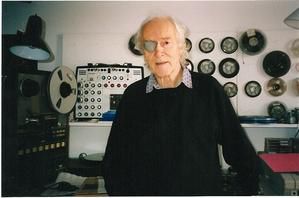Curtis Roads
Curtis Roads (b. 1951) holds a joint appointment as Professor in Media Arts and Technology (MAT) and in Music at the University of California, Santa Barbara (UCSB), where he is also Associate Director of the Center for Research in Electronic Art Technology (CREATE). He studied music composition and computer programming at California Institute of the Arts, the University of California, San Diego (BA Summa Cum Laude with Highest Departmental Honors), and the University of Paris VIII (PhD Très honorable avec félicitations). From 1980 to 1986 he was a researcher in computer music at the MIT Media Laboratory. He then taught at the Federico II University of Naples, Harvard University, Oberlin Conservatory, CCMIX (Paris), and the University of Paris VIII. He has led masterclasses at the Australian National Conservatory (Melbourne), Prometeo Laboratorio (Parma), Ionian University (Corfu), Goethe Institute (Rome), Kunitachi College of Music (Tokyo), Royal Conservatory (Aarhus), Catholic University (Porto), and the Zürich University of the Arts, among others. He is co-organizer of international workshops on musical signal processing in Sorrento, Capri, and Santa Barbara (1988, 1991, 1997, 2000). He served on the composition juries of the Ars Electronica (Linz) and the International Electroacoustic Music Competition (Bourges, France). Certain of his compositions feature granular and pulsar synthesis, methods he developed for generating sound from acoustical particles. A cofounder of the International Computer Music Association in 1979, he was Editor of Computer Music Journal (The MIT Press) from 1978 to 1989, and Associate Editor 1990-2000. His books include Foundations of Computer Music (1985, The MIT Press), Composers and the Computer (1985, AR Editions), The Music Machine (1989, The MIT Press), Representations of Musical Signals (1991, The MIT Press), The Computer Music Tutorial (1996, The MIT Press), Musical Signal Processing (co-editor, 1997, Routledge), L’audionumerique (1998, Dunod), The Computer Music Tutorial – Japanese edition (2000, Denki Daigaku Shuppan) and Microsound (2002, The MIT Press), which explores the aesthetics and techniques of composition with sound particles. A revised edition of L’audionumerique was published in 2007. A Chinese version of The Computer Music Tutorial is scheduled for publication in 2010 as a national textbook. His music is available on compact discs produced by Asphodel, MODE, OR, the MIT Media Laboratory, and Wergo. His composition Clang-Tint (1994) was commissioned by the Japan Ministry of Culture (Bunka-cho). His electronic music collection POINT LINE CLOUD won the Award of Distinction at the 2002 Ars Electronica and was released as a CD + DVD on the Asphodel label (San Francisco) in 2005. In 2007 he received a National Science Foundation grant for research in algorithms for sound analysis (dictionary-based pursuit). He is currently completing a new book Composing Electronic Music: A New Aesthetic for Oxford University Press, a revised edition of The Computer Music Tutorial for The MIT Press, and a new set of electronic music.(Bohlen-Pierce)
Publications:
Roads, Curtis (2009). Composing Electronic Music. Oxford University Press. (forthcoming)
Roads, Curtis (2001). Microsound. Cambridge: MIT Press. ISBN 0-262-18215-7
Roads, Curtis (1996). The Computer Music Tutorial. MIT Press. ISBN 0-262-68082-3
Roads, Curtis (1997). Musical Signal Processing. Routledge. ISBN 90-265-1483-2
Roads, Curtis and Strawn, John, eds (1987). Foundations of Computer Music. MIT Press. ISBN 0-262-68051-3
Curtis Roads - nscor (1980, remix 1986):
http://youtu.be/sZjpnttuAiE
nscor is the third piece in a cycle of four related works. It was organized in 1980 at the MIT Experimental Music Studio. The primary sounds material is a collection of sound objects generated from 1975 to 1980 at various studio in La Jolla, Utrecht, Toronto and Cambridge.
For every Studio visited, Curtis Roads used a different computer music system, such as the Music 11 at the MIT or the Project1 at Utrecht.
Many synthesis techniques was adopted: Frequency Modulation, Vosim, Waveshaping, Granular and many others.
The 1986 remix version was realized at Studio Strada in Cambridge.
The first movement of his composition Clang-Tint, "Purity", uses intervals from the Bohlen–Pierce scale.




 , and as a designer of industrial automation and robotic systems at Nokia’s cable machinery division (1980–1986). He also worked as a specialist consultant and Head of Planning at the Science Centre Heureka in Vantaa, Finland (1987–199
, and as a designer of industrial automation and robotic systems at Nokia’s cable machinery division (1980–1986). He also worked as a specialist consultant and Head of Planning at the Science Centre Heureka in Vantaa, Finland (1987–199





